|
|
|
Sort Order |
|
|
|
Items / Page
|
|
|
|
|
|
|
| Srl | Item |
| 1 |
ID:
139172
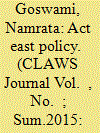

|
|
|
|
|
| Summary/Abstract |
For many years now, since 1992, when it laid its seed and slowly gathered momentum in policy circles, the “Look East” policy has been oft repeated in New Delhi’s strategic and policy circles as one of India’s foremost long-term policy visions to open up its economy for investment and trade with Southeast Asia. Increasingly now, the reference has changed from “Looking East” to “Acting East” by which one would expect that the policy is in its implementation phase. In augmenting the “Act East” policy, the northeast of India emerges, by the criterion of geography, as the region which will act as the ‘strategic catalyst’ or ‘game changer’ in accomplishing the vision that the policy aspires to embolden. Situated between China, Bhutan, Bangladesh, and Myanmar and with an international border stretching up to 4, 500 km, the region has held the promise of acting as a bridge between India and Southeast Asia for years. Its history vindicates such a role as its people have traded and travelled across the Southeast Asian region and Yunnan for years through the ancient Silk Road, trading in Himalayan salt, spices, handicrafts, food items, silk and other goods. This region witnessed migration of people from Southeast Asia and Yunnan to Assam and its surrounding hills, the most prominent being the Ahoms tracing their roots to the Tai race in Yunnan and Thailand. The Ahoms led by Sukapha arrived in Assam in
1228 A.D. and ruled over this region for 600 years. It is significant to note that the Ahoms under Lachit Borphukan successfully prevented Mughal expansion into Assam by defeating the Mughal Army in the much revered Battle of Saraighat of 1671.1
|
|
|
|
|
|
|
|
|
|
|
|
|
|
|
|
| 2 |
ID:
139176
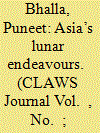

|
|
|
|
|
| Summary/Abstract |
Interest in the exploration of the Moon, much like its phases, has waxed and waned since the beginning of space exploration. The quest for the Moon was an integral part of the space race between the Soviets and the Americans in the 1960s and 1970s, which resulted in a total of 65 missions, including the six manned missions by the US, before they both shifted focus to manned space stations and missions to Mars. Strategically or militarily, the Moon did not offer them much advantage. Scientifically, there was not much that was expected to be revealed after the first few missions. Economically, there was no great rationale for continuing a high cost programme from which few commercial gains could be expected at the time. Mars offered more opportunities for national prestige, scientific discovery as well as mining prospects. In the next few decades, although there were periodic statements about the potential of lunar exploration, these did not translate into actual efforts by any space-faring nation.
|
|
|
|
|
|
|
|
|
|
|
|
|
|
|
|
| 3 |
ID:
139174
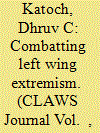

|
|
|
|
|
| Summary/Abstract |
The use of the term Naxalism has become synonymous with Maoist activities in India. All such activities are branded as Left Wing Extremism (LWE). The Maoist movement calls for a complete transformation of the political, social and economic systems as existing in India. In its essence, it challenges the validity of the Indian Constitution and rejects the Parliamentary system, seeking to replace it with a new social order. It draws its strength from existing weaknesses in society where certain vulnerable sections have been marginalised and exploited and, thus, can be penetrated and swayed by Maoist ideologues, who promise the people a fulfillment of their aspirations and a life of dignity and self-respect. The Naxal movement has a relationship to Communism. Karl Marx propounded that in order to fight feudalism and capitalism, “You must have a scientific philosophy and a sound theory, for a workers movement to be built up on a scientific basis”. In dealing with the problem of social change, Marx examined two concepts, the first dealing with the “forces of production” and the second with the “relations of production”. He was more interested in examining the military concepts of the social revolutionaries, which earlier lay in the domain of great political leaders, legislators and pioneering reformers. According to Marx, the social process would lead to revolution at a certain stage of development and the material productive forces of society would come into conflict with the existing relations of production. He emphasised that change could be
brought out only by revolution and not by peaceful means.1 The Naxal ideology flows from this line of thought.
|
|
|
|
|
|
|
|
|
|
|
|
|
|
|
|
| 4 |
ID:
139173
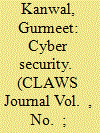

|
|
|
|
|
| Summary/Abstract |
The mellow rays of the winter sun glinted off the Drum Major’s mace as the colourfully attired pipes and drums band marched past the Chief of the Army Staff to the stirring strains of Deshon ka Sartaj Bharat at the end of the Army Day parade. In the speech that followed, the Chief exhorted the Army to be vigilant and prepared to resolutely face the challenges being constantly posed by the neighbour across the western border. The speech was telecast live to the nation and to almost half a million men deployed all along the border, waiting in a state of full readiness in strike corps concentration areas, following a major terrorist strike that led to the breakdown of diplomatic relations. As the Chief walked across to join the foreign diplomats and other guests for tea, his Military Attaché (MA) received a message on his secure cellular phone that the Command Information and Decision Support System had gone on the blink since 0945 hours and that the systems engineers were working furiously to get it operational again. The MA decided to keep the news to himself for the time being and posted an aide de camp to keep in touch with the Military Operations Directorate at the Army Headquarters.
|
|
|
|
|
|
|
|
|
|
|
|
|
|
|
|
| 5 |
ID:
139178
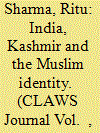

|
|
|
|
|
| Summary/Abstract |
Territory has always played a pivotal role in inter-state rivalry. John A Vasquez has said that the value of territories increases due to their strategic locations, such as if they provide access to the sea or are a source of water. But territories acquire another important dimension if they are home to ethnic and religious communities that form part of the neighbouring state.1 The state of Kashmir presents one such enduring conflict where the separatist demands in the state of Jammu and Kashmir (J&K), coupled with the irredentist claim of Pakistan, have helped in shaping a narrative in India. The popular assumption in India is that ‘Muslim separatism’ got manifested in the form of the country’s partition in 1947 and the prevalent contention is that Muslims had a choice of political identity but they chose one based on religion.2 This has resulted in an unintended linking of the Kashmiris’ demand for greater autonomy or a separate state with the identity of Muslims in the rest of India.
|
|
|
|
|
|
|
|
|
|
|
|
|
|
|
|
| 6 |
ID:
139177
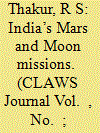

|
|
|
|
|
| Summary/Abstract |
The Moon and Mars have stirred the imagination of space scientists since ages because of their relative proximity to Earth, as compared with other heavenly bodies. The Moon, located at a distance of 38,000 km, is the heavenly body nearest to the Earth. It is natural that our satellite remained the object of the first research since the beginning of the Space Age. Mars, the fourth planet in the solar system after Earth, has a year of 687 days and a day which differs from the Earth-day by a little less than half an hour; it is smaller as well as lighter than the Earth and less dense too with its gravity just about 38 percent of the gravity on Earth. It has two satellites: Phobos and Deimos. Soon after the dawn of the Space Age in 1957, both the US and erstwhile USSR initiated numerous projects to carry out wide-sweeping reconnaissance of the solar system, including the Moon and Mars, during the 1960s and 1970s. This was followed by increasing European and Japanese activities in the area of interplanetary exploration in 1980.1 Since then, there has been an overall continuity in nations attempting interplanetary exploration. India, with its robust space programme, has been making steady progress in deep space exploration, along with other space-faring nations right from the beginning.
|
|
|
|
|
|
|
|
|
|
|
|
|
|
|
|
| 7 |
ID:
139171
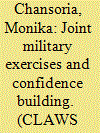

|
|
|
|
|
| Summary/Abstract |
The broad generic characterisation of Confidence-Building Measures (CBMs) is of them being a set of unilateral, bilateral, or multilateral procedural actions that primarily are put in place to decrease military tensions between state actors (nation-states) before, during or after actual conflict. States with security-related differences that could potentially lead to conflict should encourage channels to communicate regularly through consultative mechanisms with transparency measures that foster greater candidness of military cooperation. These could include pre-notification requirements, military exercises and related operating procedures. In today’s conflict-ridden world, CBMs serve as an effective tool to make a breakthrough towards the larger goal of conflict resolution. The aim of CBMs is to help build a working trust by addressing the more amenable issues by means of substantive negotiations, which, in turn, could potentially allow parties to address the more contentious aspects of a conflict.1 CBMs, thus, are not necessarily an end in themselves, but rather useful steps to negotiate and implement processes that could become bridges to reduce conflict situations between states.
|
|
|
|
|
|
|
|
|
|
|
|
|
|
|
|
| 8 |
ID:
139169
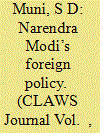

|
|
|
|
|
| Summary/Abstract |
Prime Minister Narendra Modi’s first foreign policy message was to rebuild neighbourhood relations in the South Asian region. He invited all the heads of the government of the South Asian Association for Regional Cooperation (SAARC) countries to participate in his oath taking ceremony on May 26, 2014. This was to indicate that the neighbourhood was the top priority of Modi’s foreign policy. A feeling of alienation and a degree of disenchantment had set in in India’s relations with the neighbours during the last years of the Manmohan Singh regime. Even where the Singh government wanted to push forward, like in the case of Bangladesh, it was constrained by coalition politics. In Nepal, the drift in Constitution making had vitiated bilateral relations with India. Dr. Manmohan Singh’s dream of having breakfast in Amritsar, lunch in Islamabad and dinner in Kabul got trapped in Pakistan’s inability and unwillingness to move on the question of cross-border terrorism against India. Sri Lanka and Maldives were being lured by the Chinese economic promise and strategic balancing. SAARC, being a hostage to the bilateral dynamics between India and its neighbours, has been performing far below its expectations and promise.
|
|
|
|
|
|
|
|
|
|
|
|
|
|
|
|
| 9 |
ID:
139170
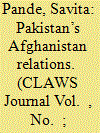

|
|
|
|
|
| Summary/Abstract |
The rise of Ashraf Ghani in Afghanistan, albeit in a power-sharing arrangement, has led to the generation of optimism in Pakistan.1 The Interior Minister of Pakistan calls it a “quantum leap in trust”.2 Pakistan was one of the first countries visited by him [including his visit to the General Headquarter (GHQ) Rawalpindi]. During his presidential poll campaign, Ghani had said, “Afghanistan and Pakistan have a choice: Do we become Asian roundabouts or do we become cul-de-sacs? The goal is a special relationship between Afghanistan and Pakistan that would resemble that of France and Germany”.3 Pakistan President Mamnoon Hussain attended the oath-taking ceremony of President Ghani which was followed by visits by the Pakistani Adviser on Foreign Affairs and National Security Sartaj Aziz and Army Chief Gen Raheel Sharif. Much bonhomie was witnessed after a trilateral ‘strategic dialogue’ held in Kabul.4 In fact, even when four Afghan officials were arrested in Peshawar, the Afghan Deputy Foreign Minister said that ties between the two countries had “entered a new phase and should not be strained by such acts”.5 Interestingly, Moeed Yusuf traces the “strategic shift” in Pakistan’s policy to the pre-Ghani period 2012.
|
|
|
|
|
|
|
|
|
|
|
|
|
|
|
|
| 10 |
ID:
139175
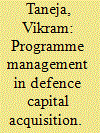

|
|
|
|
|
| Summary/Abstract |
The Indian acquisition canvas in these times is exemplified more by its failings than its accomplishments. Two accidents, one of them fatal, involving utility helicopters in February 2015, have yet again brought to the fore the grim reality of the material readiness in the Indian armed forces, the reluctant clients to a sub-optimal acquisition apparatus. Defence capital acquisition the world over, by its very nature, is a highly rigorous, time consuming and resource intensive domain. In India, acquisition involves multifarious directorates in the Service Headquarters, the Acquisition Wing in the Ministry of Defence (MoD) and the Department of Defence Production (DDP) embodying India’s burgeoning Military Industrial Complex (MIC). Regrettably, India’s armed forces, despite being the biggest arms importer in the world, endure hollowness of critical military equipment. Multiple high level committees since independence have recommended a slew of acquisition reforms, with little realisation on the ground.1 India’s defence modernisation has often been described as a parochial Army effort without the benefit of strong political direction
|
|
|
|
|
|
|
|
|
|
|
|
|
|
|
|
| 11 |
ID:
139168
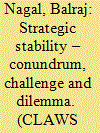

|
|
|
|
|
| Summary/Abstract |
The strategic environment in South Asia and Northeast Asia has four nuclear weapon states, of which three (China, India and Pakistan) share problems by facts of geography, history, and ideological and power competition. China seeks to determine the contours and shape of future events in the region, with its economic and military power most likely to influence the region. India looks at economic growth based on its core values and security, and a peaceful environment, to assume its rightful place
in the comity of nations. Pakistan, a revisionist state, and now a haven and nursery for terrorists, is in competition to emerge as a dominant power in the region and continues to follow policies to destabilise the region, even at the cost of hurting its own long-term national interest. Besides the direct dynamics, external influences impact the states in different ways, and all combined, these determine the strategic stability environment.
|
|
|
|
|
|
|
|
|
|
|
|
|
|
|
|
|
|
|
|
|